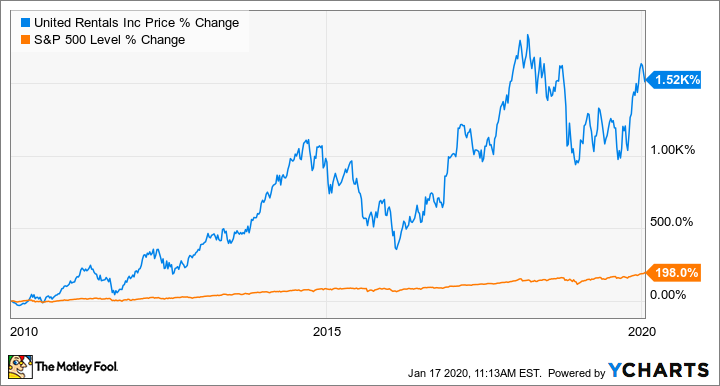Warren Buffett famously said “Our favorite holding period is forever,” and it’s good advice. Periodically reviewing your stocks is wise, but ultimately we’re looking for companies whose shares we can buy and hold for the ultra-long term — even as long as 50 years.
Personally, 50 years pushes me well beyond retirement age. Then again, life expectancy for men in the U.S. increased 13% over the past 50 years, so maybe I should be planning for a longer retirement anyway.
That’s not the only thing that has changed over the last 50 years. During this time, personal computers entered nearly every household, the internet connected the world, and we all walk around holding smartphones with capabilities that would’ve stretched credulity even 15 years ago.

IMAGE SOURCE: GETTY IMAGES.
Conceding that much can change in 50 years, I expect that United Rentals (NYSE:URI), Tyson Foods (NYSE:TSN), and Mastercard (NYSE:MA) will all still be alive and thriving a half-century from now.
As long as we keep building stuff
United Rentals isn’t a household name, but maybe it should be. The equipment company makes the bulk of its revenue through rentals for both residential and nonresidential construction projects. But it also opportunistically sells aging equipment when market prices are favorable. While that might not sound like an earth-shattering business, the stock recently traded at about $160, from around $10 a share in January 2010, making it a top-10 stock over the past decade.
There’s reason to think it can continue beating the market from here. The equipment rental market is highly fragmented. United Rentals claims to be the largest equipment rental company in the country, but it only has 13% market share. That leaves plenty of room for growth via expansion and acquisitions. In the third quarter of 2019, 11% of the company’s 15% rental revenue growth was attributable to the acquisitions of BlueLine Rental and BakerCorp.
United Rentals uses strong free cash flow ($1.1 billion through three quarters in 2019) and debt to fund acquisitions like these. These two acquisitions alone cost the company nearly $3 billion. But it also repurchases a lot of its stock — outstanding shares are down 7% year over year.
Construction projects aren’t ever going away. As long as renting equipment makes more sense than buying, I expect this company to be fine. Despite double-digit revenue and earnings growth, it only trades at 8 times forward earnings. These are all reasons I recently added it to my IRA.
As long as we keep eating stuff
Unlike United Rentals, Tyson Foods needs no introduction. The food titan has four business segments: beef, pork, chicken, and prepared foods like its Jimmy Dean brand. Excluding acquisitions and tax law changes, revenue and net income were essentially flat from 2018 to 2019. But the company is becoming a steady dividend player, raising it annually over the last five years. While the dividend yield is still under 2%, the payout ratio is only 27%, which means future annual increases are likely.
One specific reason that now may be a great time to buy Tyson is the U.S. and China signing off on phase one of a trade deal. Under the deal, China agrees to purchase around $200 billion of U.S. goods.
The deal includes $32 billion in agricultural goods over the next two years, with pork cited specifically. That’s logical since China is struggling with its domestic pork production. Tyson already exports to China, meaning it could be a major beneficiary of the trade deal.
Another reason to like this company long term is its willingness to experiment with new products, like plant-based meats. Hype for these protein alternatives has surged of late, and interest could retreat once the novelty fades. But if this is a legitimate long-term trend, Tyson is preparing to meet demand with its own line of plant-based chicken, pork, and beef alternatives. To be clear, it’s not abandoning its legacy operations — just adding new products to stay in front of eating trends.
As long as we keep buying stuff
The war on cash is real. We’re increasingly moving away from cash, which is propelling digital payment network companies like Mastercard higher. According to the World Cash Report from G4S, a British multinational security services company, approximately 32% of payments in the U.S. were made with cash in 2018. But outside the U.S., cash usage is much higher. For example, the report estimates that in Europe, cash makes up 79% of all transactions by volume.
That’s particularly good news for Mastercard, since it already has a large international presence. In its third quarter 2019, international revenue accounted for 64% of Mastercard’s total.

IMAGE SOURCE: MASTERCARD.
In 50 years, many countries may be completely cashless. Governments certainly have incentive to do this, as it would provide a digital record of all transactions. And real-life examples show this shift can happen quickly. Consider that between 2016 and 2018, cashless transactions in Sweden grew 25% and now make up 80% of all transactions. Some believe the country could be completely cashless by 2023.
The point is, as long as the world keeps going cashless, and commerce continues (both should be givens), then Mastercard should be one of the big winners. Through three quarters in 2019, Mastercard’s revenue is up 12%, including 13% international growth. But I wouldn’t be surprised if that growth accelerated. While not a big dividend payer (less than 1% yield), of the three companies discussed here, Mastercard is the one I’m most confident will be thriving 50 years from now.
Fool.com




